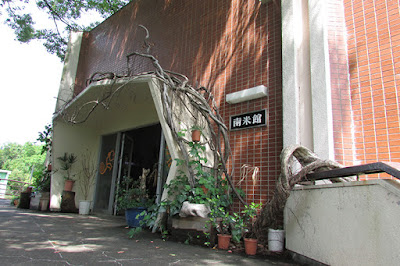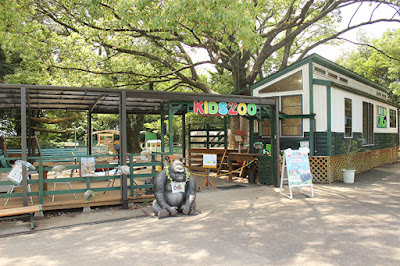The
Japan Monkey Centre is a specialized zoo that was founded in 1956 for primate
research, conservation and education. The JMC claims to have the largest number
(over 60) of nonhuman primate species in the world in its collection, and it
receives many visitors (including researchers) from around the world. The JMC is located in Inuyama
City , a quiet community outside of Nagoya in Aichi
Prefecture Nagoya
Since
the JMC is in large part purposed for research, and because some of the
enclosures are old, there are some “concrete and cages” exhibits that many
visitors will not like. But, at the same time, there are some enclosures which appear
to provide good environments for the resident animals that can be quite attractive
to the typical tourist. For people who love
monkeys, I think this relatively unknown zoo has the potential to become as
popular as the Miyagi
Zao Fox
Village
This
zoo had many exhibits with original names.
I will discuss them one by one.
Monkey Scramble
After entering the JMC, one of
the first features that visitors will see is the “Monkey Scramble”, a complex
of connected structures which allow some monkey residents a certain amount of
freedom of movement between areas. The first of these structures is the “Monkey
Skyway” a 100-meter long suspension bridge hanging about 6 meters above the
ground. Some parts of the skyway hang over areas where zoo visitors walk, and
visitors are warned to be wary of falling objects or liquids (of the organic
kind). Spider monkey walking on “Monkey Skyway”
A second structure is the “Big Loop”, basically a giant jungle gym for Siamangs (Symphalangus syndactylus).
The third structure is the “Eco dome” which is connected to the “Big Loop” by a sky trail consisting of metal pipes and horizontal handholds.
Visitors cross a bridge and pass through a double gate to gain entrance to the island, and once inside the enclosure, visitors are in the monkeys’ environment.
Signs explaining rules for visitor behavior while inside the enclosure. Rule number one is “Please don’t touch the monkeys”. Rule number two prohibits the carrying of food while on the island.
This sign warns of the electrified wires which keep the monkeys from climbing over the bridge.
Other warning signs:
Various photographs of the Bolivian Squirrel Monkeys on the island – very cute little critters
I am not particularly a monkey fan, but I was so charmed by the little Squirrel Monkeys that I would have been willing to spend the better part of a whole day on this island alone. For monkey lovers, this island area alone is probably enough to justify the 600-yen price of admission to this zoo.
There
was a considerable amount of grassy area for the lemurs to use, and there was
an inner secured area where the lemurs spend each night.
When the zookeeper moved a few meters, the lemurs also moved to follow her. I am not sure whether they were expecting a treat from her or if they were seeking her protection from the large human intruders from outside.
This area featured a scaffold structure on which the macaques could climb.
For 100 yen, visitors could buy small cups of food to give to the macaques.
Feeding the macaques basically meant throwing the food to them from a lookout platform.
This macaque waits for a snack to be thrown his way.
Gibbon’s House
This exhibit included two
structures, each had a center building flanked on both sides by a cage-type
display area.White-handed gibbon (Hylobates lar)
Zoo directory map featuring colorful characters
Just
like at “Monkey Valley
This complex housed the
chimpanzees, gorilla, and mandrills.
On the day of my visit, there was a mother and child chimpanzee out in the exhibit area.
Outdoor portion of Mandrill enclosure – this was connected to an indoor area. Due to darker lighting conditions I failed to get a usable photo of the indoor portion of this enclosure.
Indoor portion of Lowland Gorilla (Gorilla gorilla) enclosure
Outdoor
portion of Gorilla enclosure
Indoor
portion of second Chimpanzee enclosure
Outdoor
portion of second Chimpanzee enclosure
This area housed Black lemurs,
Brown lemurs, and Ruffed lemurs. The enclosures were arranged in a row and
could be viewed through windows.
View
of lemur through window.
The
lemurs’ indoor enclosures were connected to three outdoor areas separated by
electrified fences and surrounded by a water barrier. In this set-up, three sets of lemurs could be
allowed outside at any one time.
South American House
This building had an outdoor
portion and an indoor portion. The indoor
portion housed different varieties of marmosets and tamarins.
The
indoor temperature was kept at about 25 degrees Celsius, and because humidity
is controlled to replicate the environment found in the South American
rainforest, it was slightly uncomfortable.
Making matters worse, the indoor areas have the strong smell of
urine. According to the JMC homepage,
these animals communicate a lot using smell, so they do a lot of scent marking.
Common
Marmoset (Callithrix jacchus)
Asian House and African
House
These two areas consisted
mostly of concrete and cage designed enclosures, and it was impossible to get a
good photo of any of these specimens.
Abyssinian
Colobus (Colobus guereza)
Tibetan
Macaque (Macaca thibetana)
Opportunities for
Animal Encounters
Basically,
the rule throughout the JMC is that visitors may not touch the monkeys. The only place that visitors could touch any animals
was the “Kid’s Zoo”, a small area which cost an additional 200 yen to enter. According to the homepage, there are fluffy
animals such as goats, degus, guinea pigs, and rabbits, exotic animals such as Madagascar
Educational Efforts: Visitor Center
As mentioned earlier, the JMC
was founded in 1956 for primate research, conservation, and education. In 1957,
the JMC was registered under Japanese law as a museum. The visitor center has
an auditorium room for lectures and workshop rooms for many educational
activities. There are also educational
displays and taxidermy specimens of many of the species housed at JMC.
The displays
were interesting, but most could have used more English.
Food and Souvenirs
There
were two places to buy food at JMC.
There was a restaurant that served modern Japanese dishes like curry
rice, ramen noodles, udon noodles, and miso-cutlet plates.
There
was also a small food concession that sold wieners on a stick, corn dogs,
French fries, and shaved ice.
Inside
of the Visitor Center Japan Monkey Centre
These
small hand towels were very cute.
One
of the more charming items was the lemur dolls that were handmade in
Madagascar.
Getting There
To
get to the Japan Monkey Centre from Nagoya Station, take the Meitetsu line to
Meitetsu Inuyama Station. If you ride an
express train, the ride should take less than 30 minutes. From Meitetsu Inuyama
station, it takes about 5 to 10 minutes by bus or taxi. I caught a taxi, and it
cost me 1050 yen. The JMC homepage also
mentioned being able to walk from the train station to the JMC in 20 minutes,
but in the mid-summer heat, I didn’t want to try it. Admission was 600 yen for adults, 400 yen for
elementary and junior high school students, 300 yen for preschool children (age
3 years and up), and free for children under 2 years old. The JMC is closed
every Tuesday and Wednesday and some other weekdays. Visitors should check the
homepage calendar before making the trip.
(Note:
The photos taken in this post were taken during a visit on July 8, 2017. The comments in this post are based on observations
made on that day. Conditions may have
since changed. Please check it out for
yourself!)













































































